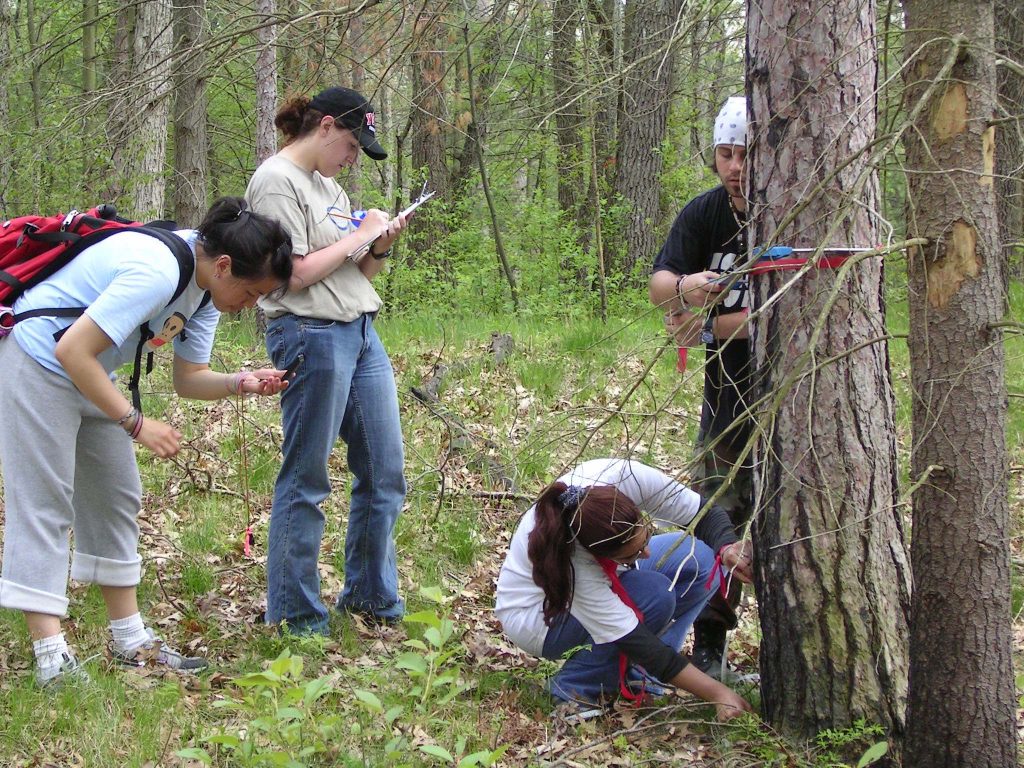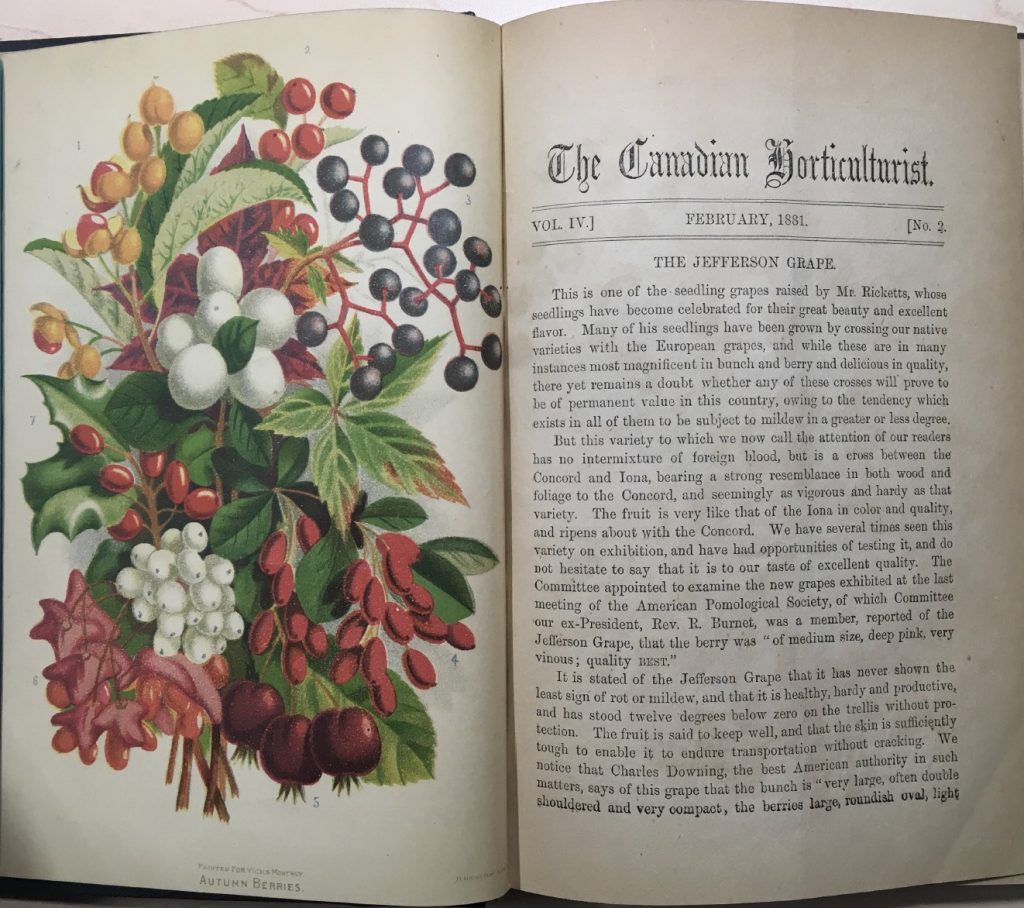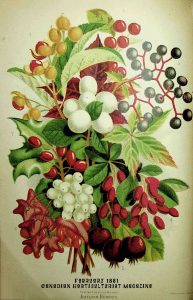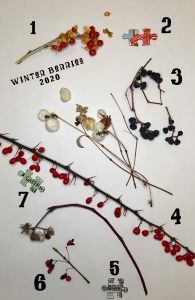By Dawn Bazely
The Snowberry makes a great hedge

It seemed a bit strange that the native North American shrub, the Snowberry[6] (Symphoricarpos albus), named for obvious reasons, hadn’t yet appeared in the Advent Botany series. When I asked, Alastair told me that it was on his “some-day” plant list, so I offered to write about this common hedge plant in my neighbourhood.
Wild snowberry
I first got to see a lot of this plant in the 1990s to 2000s, while doing field work on the impacts of browsing and grazing by white-tailed deer in Pinery Provincial Park. Snowberry, with its attractive pink flowers and opposite leaves, is a distinctive, common, trailing plant in the Black Oak Savanna plant communities.

So, let’s stay in the province of Ontario. As with today, in the 19th century, magazines needed paid subscriptions to generate operating revenue. The Canadian Horticulturist [3] Magazine was launched in 1878 by the Fruit Growers’ Association of Ontario, and soon adopted the practice of luring potential subscribers with free gifts, including the first ever gardening book written specifically for Canadian gardens, by Mrs Annie L. Jack[1].
Colour plates
The association’s members were predominantly commercial fruit-growers, but they well knew that many of their magazine subscribers and readers included women interested in horticulture. The team behind the Canadian Horticulturist Magazine recognized the need to cater to this group. So, early on, the magazine included colour plates like these Autumn Berries from the February 1881 issue.

Plant identification
The beauty of these plants in the winter landscape is extolled, including, clockwise: (1) Climbing Bitter-sweet (Celastrus scandens), (2) Whorled Winterberry (Black Alder/Prinos verticillatus – now, Ilex verticillata), (3) Virginia Creeper (Ampelopsis quinquefolia – now, Parthenocissus quinquefolia), (4) European Berberry (Berberis vulgaris), (5) Crataegus species, (6) European Euonymus or Spindle Tree, and (7) American Holly (Ilex opaca), with Snowberry (Symphoricarpus racemosus (sic): centre top), and Dogwood (Cornus stolonifera) (centre bottom).
I thought it would be fun to see how many of the 1881 berries I could find in my neighbourhood, and managed to locate most of them, except for 2, 5 and 7, though I think I know where to find bushes and trees belonging to these genera! They have lost their berries, by now.
It’s great to see an article from 140 years ago recognizing native species as being desirable for Canadian gardens when “the snow covers the ground with its mantle of white”. I was gratified at the number of indigenous, Snowberry hedges I found in my neighbourhood.
Invasion
I should also note that a number of the non-native shrubs touted in the 1881 article have long been considered invasive in North America[5]. In my montage, the berries at number 4 are not European, but the invasive (in Pinery Provincial Park) Japanese barberry, Berberis thunbergii. Number 6 is not the European Spindle, but the invasive Burning bush, Euonymus alatus. This is about as common in my neighbourhood than Japanese barberry.
I do know the location of ONE native Spindle tree, Euonymus atropurpureus, in the York University Boyer Woodlot, but I have not seen it for about ten years. I will file a report on its status in the spring.
Editor’s notes
Snowberry can be quite invasive in the UK so should be planted with caution. While it is not listed on Schedule 9 of the Wildlife and Countryside act it can be difficult to remove once established especially in wetter areas of the U.K.. You can read more about Snowberry in the Uk in Tomos Jones’ blog from AdventBotany 2018.
Ay my request Dawn has provided me with some additional text relating to this article and women in STEM that you can read here.
References
1. Annie Jack. n.d. In Wikipedia. Retrieved December 21, 2020. https://en.wikipedia.org/wiki/Annie_Jack
2. Anonymous. 1881. Autumn Berries. Canadian Horticulturist. 4(2):26-28. https://www.biodiversitylibrary.org/item/78235#page/40/mode/1up https://www.biodiversitylibrary.org/item/78235#page/42/mode/1up
3. The Canadian Horticulturist archive at Canadiana online. www.Canadiana.ca https://www.canadiana.ca/view/oocihm.8_04048
4. The Canadian Horticulturist archive at the Biodiversity Heritage Library. https://www.biodiversitylibrary.org/bibliography/83729#/summary
5. Ontario Invasive Plant Council. n.d. A Quick Reference Guide to Invasive Plant Species. 40 pp. https://www.ontarioinvasiveplants.ca/wp-content/uploads/2016/07/QRG_FINAL.pdf
6. Snowberry (Symphoriarpos albus). n.d. In Wikipedia. Retrieved December 21, 2020.: https://en.wikipedia.org/wiki/Symphoricarpos_albus


